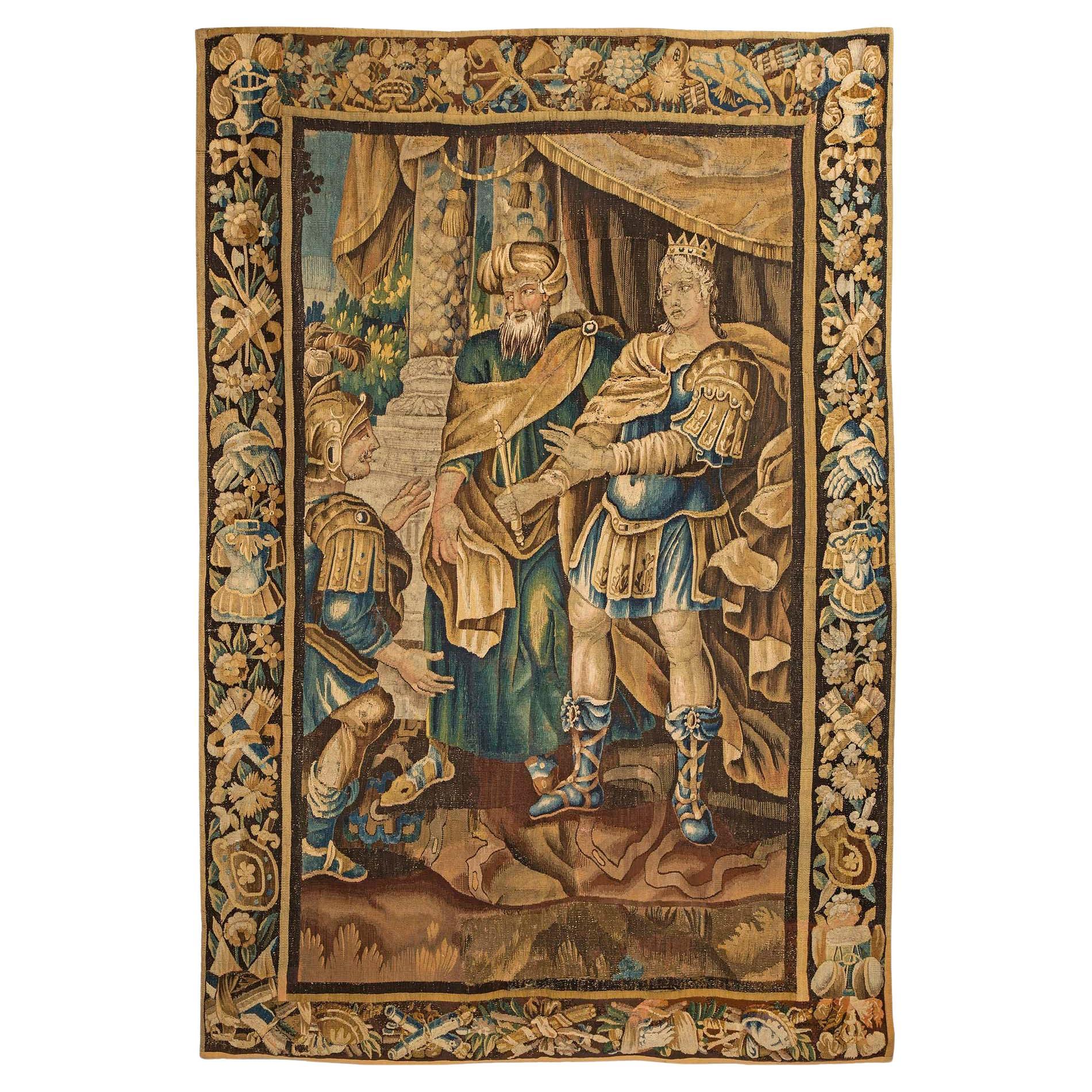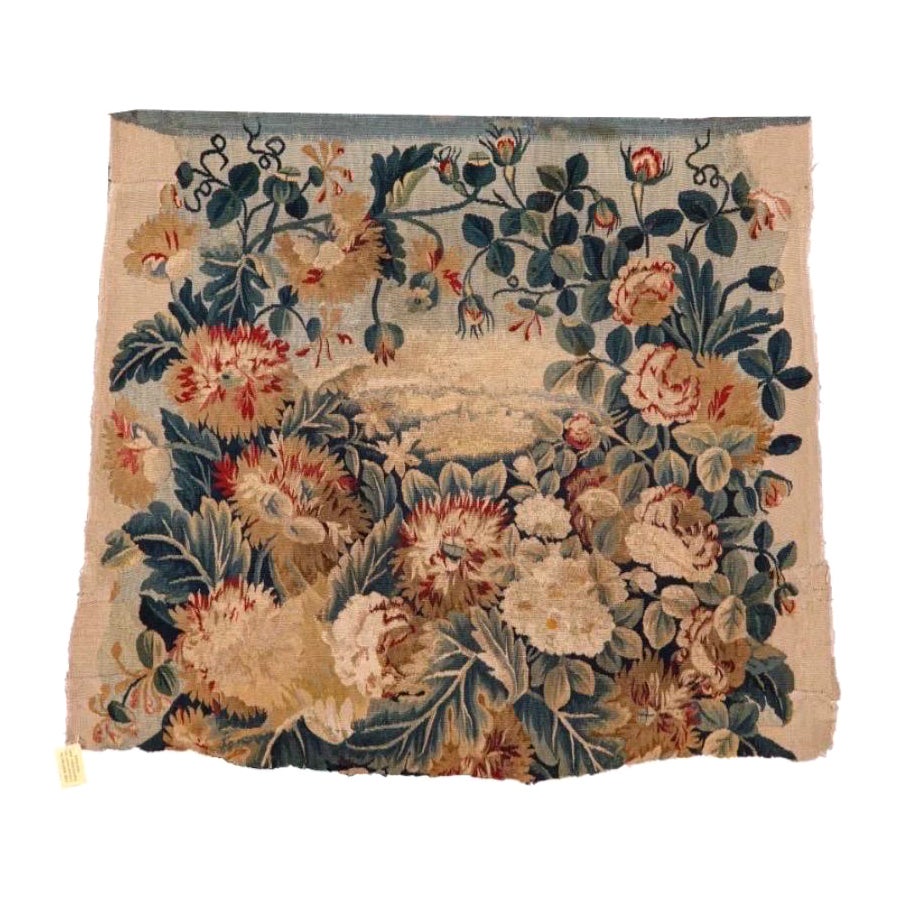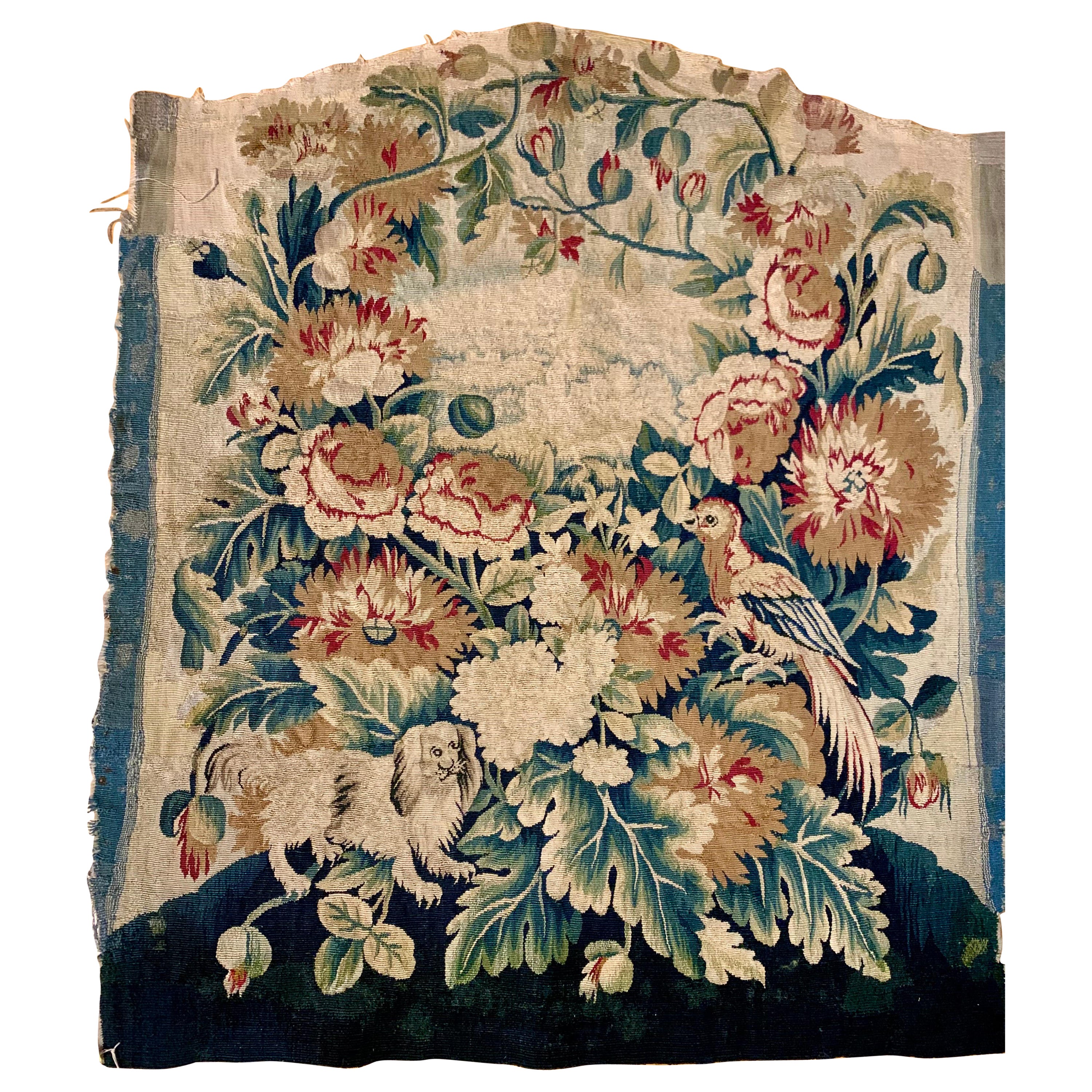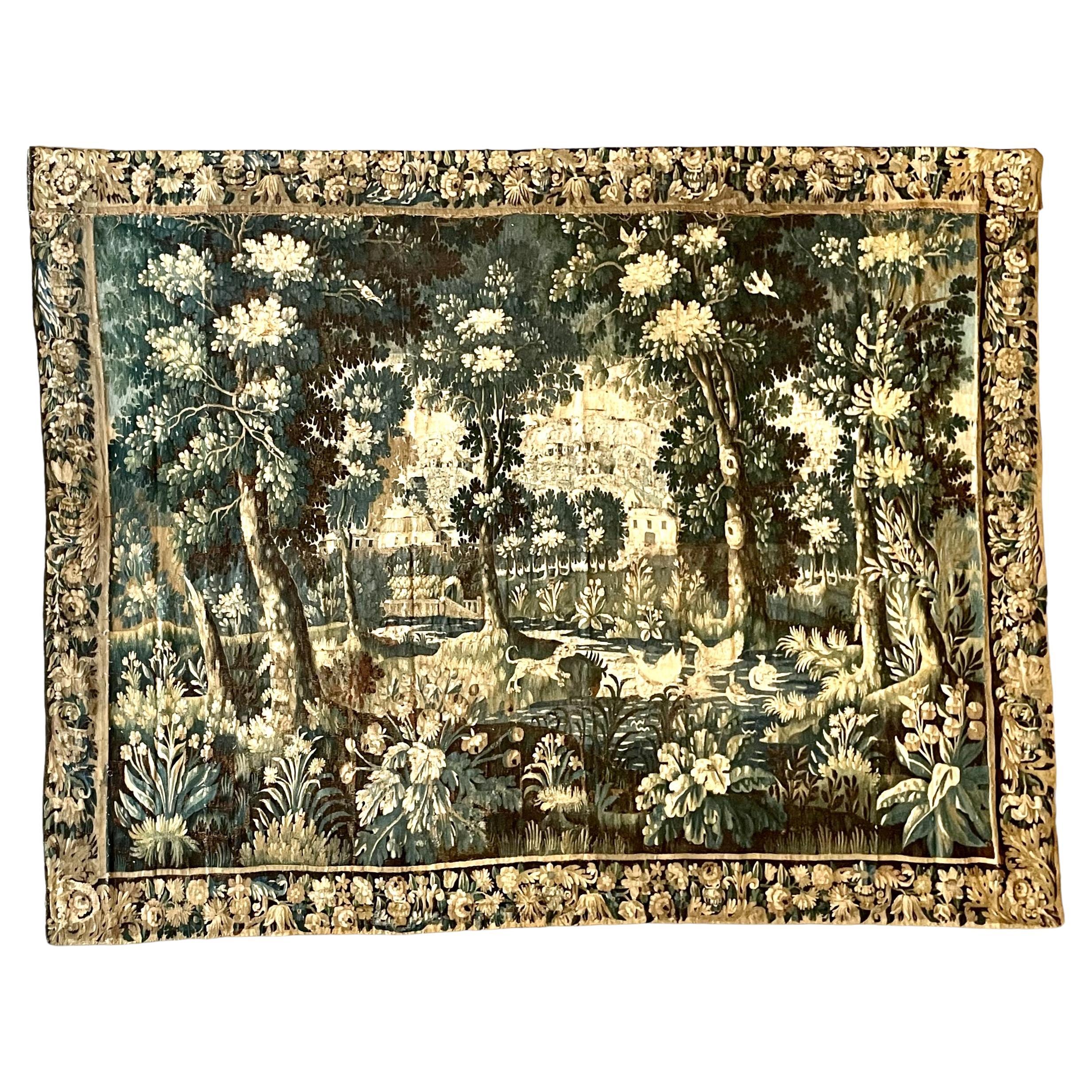Items Similar to 18th Century French Wool and Silk Aubusson Tapestry and Engraving, circa 1750
Video Loading
Want more images or videos?
Request additional images or videos from the seller
1 of 22
18th Century French Wool and Silk Aubusson Tapestry and Engraving, circa 1750
About the Item
La Jeunesse (Youth)
Tapestry
Polychrome wool and silk
France, Aubusson, circa 1750
It measures 107.08 in height x 104.33 in (272 cm height x 265 cm).
State of conservation: good
The tapestry is accompanied by the engraving from which the subject was taken.
The engraving measures 23.50 in x 25.86 in (59.7 cm x 65.7 cm) with the frame.
The Aubusson tapestry has controversial origins: some believe that it was the Saracens who imported this type of work into Europe while other authors believe that the production began at the same time as the marriage between Louis I of Bourbon and Maria de Hainaut in 1310. It was at this time that a considerable importation of tapestries from Flanders into France began, followed shortly thereafter by the importation of their production techniques.
At the beginning of the seventeenth century a royal edict from Henry IV halted the importation of Flemish tapestries, contributing to the subsequent Expansion of Aubusson production. The status of royal manufacture was to be granted only in 1665, even though the Nantes edict caused a drop in production because of the forced migration of weavers to Germany.
The full recovery and the success of the manufacturing took place during the eighteenth century when the great painters and the tapestry manufacturers began to collaborate.
Great French artists of the time and specialist painters, the “cartonniers”, painted “cartons de tapisserie” in oil or tempera, all of which were to be a source for the tapestries. As an alternative to the “cartons”, scenes taken from prints and engravings were freely used.
The tapestry in question, made of wool and silk, is in good condition; the colors are still fresh and the silks, which give brightness to the scene, are well preserved. There are a small number of integrative restorations present, while the lining and the suspension system have been recently refurbished.
The work is made with a flat-weave, according to the custom of the Aubusson manufactures, which is clearly demonstrated by this work since it shows all the technical and material characteristics typical of the first half of the eighteenth-century production: the “Jeunesse” was probably woven in the middle of the XVIII century.
The scene itself is compelling: a rural clearing is depicted, centered around a tall tree with dense fronds with lance-shaped leaves. In the shade of this tree some scenes of courtship can be seen. A couple hugs each other, one is caught stealing a kiss and another, lying softly on the grass, is still at the early stages of courtship: together with the suitor the girl looks with smiling malice at the kissing couple. On the right, two young men practice archery while aiming at a target placed on top of a pole.
The scene, with male and female characters intent on games and gallantry in a festive atmosphere, is taken - faithfully, but in mirror-image - from an engraving, which in turn was itself taken from the painting (now kept at the National Gallery in London, inv. NG103 and part of a series with the four ages of man) by Nicolas Lancret, produced around 1735.
The tapestry is accompanied by a copy of the engraving, which bears, at the bottom, the name of the author (“N. Lancret pinxit”), the name of the engraver (“N. De Larmessin sculpsit”) and four short verses on the subject of love disputes:
Pourquoi tous ces combats si chers a la jeunesse,
Quels frivoles talents veut-elle mettre au jour?
Non: chacun voudroit vaincre aux yeux de sa Maitresse,
La Lice est une Scène ou triomphe l’Amour.
Why all these fights so dear to youth,
What frivolous talents does it want to bring to light?
No: everyone would want to win in the eyes of his Mistress,
The Lice is a Scene where Love triumphs.
At the bottom we read: “A’ Paris chez N. De Larmessin graveur du Roy Rue de Noyer à la 4 (?) porte cochère a droite entrant par la Rue St. Jacques A.P.D.R. [Avec Privilège Du Roy]”.
Nicolas Lancret (1690-1743), along with Antoine Watteau, was a pupil of Pierre Durin and Claude Gillot, and became a member of the Academy of Fine Arts in Paris in 1719. He was famous for festive and genre scenes and was greatly appreciated in all the main European courts.
- Creator:Aubusson Manufacture (Manufacturer)
- Dimensions:Height: 107.09 in (272 cm)Width: 104.34 in (265 cm)Depth: 0.4 in (1 cm)
- Sold As:Set of 2
- Style:Rococo (Of the Period)
- Materials and Techniques:
- Place of Origin:
- Period:
- Date of Manufacture:circa 1750
- Condition:Refinished. Minor structural damages. Minor fading. There is a small number of integrative restorations present, while the lining and the suspension system have been recently refurbished.
- Seller Location:Milano, IT
- Reference Number:1stDibs: LU4352214341322
About the Seller
4.3
Vetted Seller
These experienced sellers undergo a comprehensive evaluation by our team of in-house experts.
Established in 1860
1stDibs seller since 2018
19 sales on 1stDibs
Typical response time: 4 hours
Associations
International Confederation of Art and Antique Dealers' Associations
- ShippingRetrieving quote...Ships From: Milano, Italy
- Return PolicyA return for this item may be initiated within 14 days of delivery.
More From This SellerView All
- Six Mid-18th Century Italian Chairs, Venice, circa 1750Located in Milano, ITSix carved walnut chairs Venice, mid-18th century Height 35.03 in (18.70 in to the seat) x 19.09 in x 18.30 in (89 cm - 47.5 cm to the seat - x 48.5 cm x 46.5 cm) lb 80 (kg 36) Stat...Category
Antique 1750s Italian Rococo Dining Room Chairs
MaterialsWalnut
- 18th Century Italian Maiolica Centerpiece Bassano Venice, circa 1750Located in Milano, ITMaiolica centerpiece Pasquale Antonibon factory Nove di Bassano, Venice, 1740-1770. Measures: 1.85 in x 19.21 in x 15.27 in 4.7 cm X 48.8 cm X 38.8 cm. lb 5.29 (kg 2.4) State of conservation: thin passing fêlure with covered chipping and a glued foot The Antonibon were an important family of Venetian...Category
Antique 1750s Italian Baroque Ceramics
MaterialsMaiolica
- Mid-18th Century Italian Pair of Armchairs with Leather Covers, Milan circa 1750Located in Milano, ITPair of armchairs Original impressed leather covers Milan, circa 1750 They measure: 40.94" high [18.11" to the seat] x 21.65" in deep x 27.55". 104 cm high (46 to the seat) x 55 ...Category
Antique 1750s Italian Rococo Armchairs
MaterialsLeather, Walnut
- 18th Century Italian Maiolica Dish Milano, circa 1770Located in Milano, ITMaiolica dish, "Famille Rose" and gold decoration Felice Clerici factory Milan, 1770-1780 8.93 in (22.27 cm) in diameter lb 0.66 (kg 0.3) State of conservation: perfect, except for ...Category
Antique 1770s Italian Rococo Ceramics
MaterialsMaiolica
- 18th Century, Italian Maiolica Flower Pot, Pasquale Rubati, Milan, 1770 circaBy Pasquale RubatiLocated in Milano, ITMaiolica flower pot “a mezzaluna” decorated with trompe l’oeil Pasquale Rubati Factory Milan, 1770 circa It measures: 4.7 in (cm 12) X 5 in (...Category
Antique 1770s Italian Rococo Ceramics
MaterialsMaiolica
- Ancient Italian Walnut Mirror, Venice, Circa 1750Located in Milano, ITCarved, sculpted walnut mirror Venice, about mid-18th century It measures 53.93 x 33.46 in (137 x 85 cm); weight 30.86 lb (14 kg) State of conservation: slight gluing The walnut mirror has an elongated rectangular shape, crowned with a decorative three-lobed sculpted and carved molding. The frame encircles the mirror with a series of rabbet grooves. A rocaille carved molding is attached above, showing off its curved decorative elements. These descend along the sides of the mirror frame and are further enhanced with the presence of volutes "pennaccette", small leafy elements and minute buds. The mercury mirror is original. As a decorative element, mirrors represent a refined expression of the Rococo style in Venice around the middle of the XVIII century. During this period, decorated mirrors, previously use...Category
Antique 1750s Italian Rococo Wall Mirrors
MaterialsWalnut
You May Also Like
- French 18th Century Aubusson Tapestry, Circa 1750Located in West Palm Beach, FLA large scale and very high quality French 18th century Aubusson tapestry likely depicting Alexander the Great, circa 1750. The ...Category
Antique 18th Century French Tapestries
MaterialsTapestry
- Late 18th C. French Aubusson Tapestry Silk & Wool Seat FragmentBy Aubusson ManufactureLocated in New York, NYThis is a silk and wool seat cover fragment from antique 18th Century French Aubusson chair. Seat cover woven in wools and silks, each with flor...Category
Antique 1680s French Aubusson Tapestries
MaterialsWool
- Late 18th C. French Aubusson Tapestry Silk & Wool Seat FragmentBy Aubusson ManufactureLocated in New York, NYThis is a silk and wool chair back cover fragment from antique 18th Century French Aubusson chair. Chair back woven in wools and silks, each wit...Category
Antique 1680s French Aubusson Tapestries
MaterialsWool
- 18th Century French Aubusson Tapestry "Verdure"By Aubusson ManufactureLocated in LA CIOTAT, FRA luxurious 18th-century Aubusson tapestry, depicting a dog barking at fowl on a river, in a typically rural and architectural-themed landscape. Hand-woven in wool, in predominantly ...Category
Antique 18th Century French Tapestries
MaterialsWool
- 18th Century French Pair of Aubusson TapestriesBy Aubusson ManufactureLocated in LA CIOTAT, FRStep into a world of timeless beauty with these exquisite Aubusson tapestries ! Imagine adorning your home with these stunning door curtains that depict the enchanting seasons of Spr...Category
Antique 18th Century French Régence Tapestries
MaterialsWool, Silk
- 18th Century Aubusson Portrait TapestryBy Aubusson ManufactureLocated in London, GBAn 18th century portrait tapestry, depicting a Roman emperor wearing a laurel wreath, holding an olive branch, signed Manufacture Royal Aubusson.Category
Antique 18th Century French Aubusson Tapestries
MaterialsWool
Recently Viewed
View AllMore Ways To Browse
Brown Aubusson
French Tapestry Painting
Silk And Wool Top
Love Tapestry
Antique European Tapestries
Antique European Tapestry
18th Century Aubusson
Aubusson Mid Century
Silk Girl
Aubusson Louis
French Mid Century Wall Tapestry
French Midcentury Wall Tapestry
Aubusson Silk
Small Wall Tapestries
18th Century Aubusson Tapestry
Tapestry Royal
Flemish Tapestries
Flemish Tapestry





